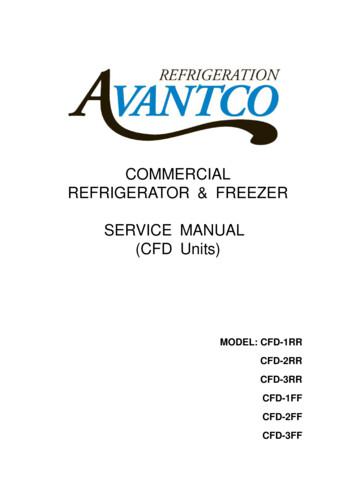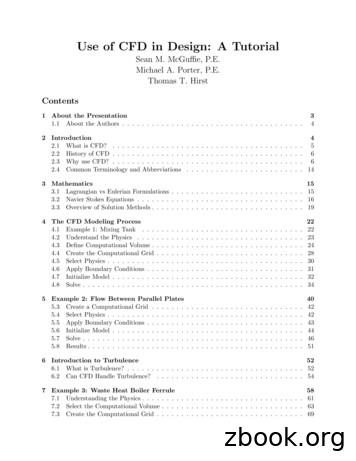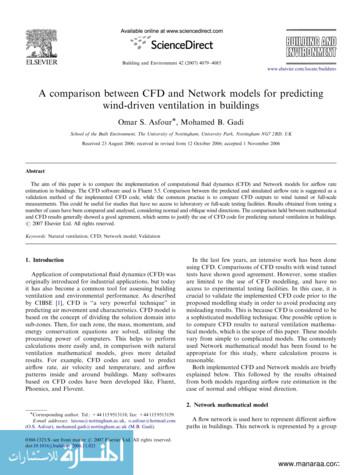Use Of CFD As A Design Tool For Scale -Up Of Fluidized-bed Reactors
Use of CFD as a Design Tool for Scale-Upof Fluidized-bed ReactorsRanjeeth Kalluri, Jing Huang, Aqil Jamal,Brian Turk and Raghubir GuptaCenter for Energy Technology,RTI International, Research Triangle Park, NCNETL 2010 Workshop on Multiphase Flow Sciencewww.rti.orgRTI International is a trade name of Research Triangle Institute
RTI views CFD as a Critical Design Tool RTI has an extensive pipeline of fluidized-bed processesMany technologies are entering pilot-scale and commercial-scale demonstrationphasesBench scalePilot scaleCommercial scaleCFD modeling offers tremendous benefits forRTI’s scale-up and commercialization efforts2www.rti.org5/14/2010
RTI’s Fluidized-bed Reactor Technologies High temperature desulfurization process(HTDP) Dry carbonate CO2 capture Transport reactor-based Sabatier process forCO2 reuse SNG production with catalytic gasification intransport reactor Hydrogen production using steam-iron process Syngas clean-up using ‘Therminator’ technology Chemical looping combustion Co-gasification (Coal & Biomass) Catalytic biomass pyrolysis3www.rti.org5/14/2010
Integrated Gasification Combined Cycle (IGCC)R&D objective: Platform of warm syngas cleaning technologies providing improved efficiency,environmental performance, and costwww.rti.org5/14/20104
Process Integration – Modular ApproachGasifierWaterQuenchPowerSOx 1.4 lb SOx/MWh grossNOx 1.0 lb NOx/MWh grossSourShiftPM 0.0071 lb/MMBtuHg 90% ur 50 ppbAs 5 ppbHCl 10 ppbSe 0.2 ppmNH3 10 ppmCd 30 ppbCO2 90% removalHg 5 ppbw[NETL 2007]Sulfurwww.rti.orgCO2 for use/sequestration5/14/20105
High Temperature Desulfurization Process (HTDP)ZnO H2S ZnS H2OZnO COS ZnS CO2(600 -1000ºF)(300-600 psig) Dual loop transport reactor system Similar to FCC process designZnS 3/2O2 ZnO SO2(1200-1400ºF)(300-600 psig)Desulfurizer High temperature sulfur (H2S andCOS) removalSO2 / N2TO DSRPRegeneratorCLEAN SYNGAS Patented ZnO-based attritionresistant sorbent (RTI-3)REGENERATEDSORBENTREGENERATED SORBENTTO ABSORBER MIXING ZONERAW SYNGASN2/O2RTI – Eastman High Temperature Desulfurization Process6www.rti.org5/14/2010
Pilot Plant Field TestingExtensive pilot plant tests completed at Eastman ChemicalCompany with coal-derived syngas. High Temperature Desulfurization Process (HTDP)– 99.9% total sulfur removal (H2S and COS) for 3,000 hours– Low attrition rates 31 lb/million lb circulatedPressure, psigInlet Concentration, S ppmvEffluent Conc. S ppmv RangeS Removal, 65.73.3–18.199.9399.8299.90More than 3,000 hours of syngas operation7www.rti.org5/14/2010
50 MWe Protoype Unit of Warm Syngas Clean-upTechnology600 MWeUnit ?0.3 MWe Unit atEastman Chemical50 MWe Unit to be commissionedin 2012 at Tampa Electric, PolkPower stationRTI and DOE/NETL’s Computational and Basic Sciences Group are using CFDmodeling to assist in the design of HTPD for 50 MWe Prototype Unit8www.rti.org5/14/2010
NETL’s CFD Modeling Approach: SeparateDesulfurization and Regeneration Reactor ModelsBoundary ofdesulfurization reactorBoundary ofregenerator reactorCLEAN SYNGASREGENERATEDSORBENTRAW SYNGASSO2 / N2TO DSRPREGENERATED SORBENTTO ABSORBER MIXING ZONEN2/O2RTI – Eastman High Temperature Desulfurization Processwww.rti.org5/14/20109
Comparison of NETL’s Models Predictions withPilot Plant DataDesulfurization ReactorTagDescriptorUnitMeasurementCFD PredictedTIC-212TIC-228PDT- 210PDT-215PDT-220Mixing Zone TRiser Zone TMixing Zone DpTransition DpRiser Dp F Fin. H2Oin. H2Oin. H2O829856363020862865122326 Acceptable agreement between measured andpredicted pressure drop values Agreement between measured and predictedtemperature values are less favorable. thermal boundary condition of the reactor walls assumed constant temperature wallRegeneration ReactorTagDescriptorUnitMeasurementCFD 8TIC-329PDT-310PDT-315PDT-320Mixing Zone TMixing Zone TMixing Zone TMixing Zone TMixing Zone TRiser Zone TRiser Zone TMixing Zone DpTransition DpRiser Dp F F F F F F Fin. H2Oin. H2Oin. 9613911380137542342510www.rti.org5/14/2010
Path Forward for HTDP CFD Modeling Validate NETL’s CFD models with data from Eastman testing Use validated models to assist in design of 50 MWe prototype unit Reactor geometries (heights, diameters, return leg locations, gas/soliddistribution) Optimize hydrodynamics and reaction kinetics for maximum performance Evaluate start up and shut down procedures for prototype unit Develop CFD modeling options for dual loop HTDP system Evaluate regenerator heat integration Optimize use of exothermic regeneration heat to heat incoming solids Evaluate options for system start up Light off additives Fuel injection Optimize solids feed control for regeneration reactor11www.rti.org5/14/2010
RTI’s Dry Carbonate ProcessCapture and Purification of CO2 from Power Plant Flue GasNa2CO3 (s) CO2(g) H2O(g) 2NaHCO3(s)60 C1 atm120 C1 atmStackCO2 H2OComp.Water50-60 CFlue GasLow SO2High CO2 H2Owww.rti.orgFlue GasLow CO2RegeneratorCFD ModelingOpportunities Heat transfer(absorber andregenerator) Solids handling Pressure drop Gas/solid distributionCO2 AdsorberFlue GasHigh SO2High CO2WFGDCooled SorbentNa2CO3CO2-Loaded SorbentNaHCO35/14/2010Hot SorbentNa2CO3CO2RecycleCO22200 psia12
Heat Transfer – Reactor DesignParameters Tube Layout Superficial Gas Velocity Solids Circulation Rate Gas Distributor Layout Sorbent Properties(Particle size, shape, density,thermal conductivity, etc.)Uncertainties Fluid dynamics in reactorSystem PSolid density distributionThermal gradientsHeat transfer coefficientsMass transfer ratesMixing, bubbling phenomenaCombination of CFD modeling and actual prototypetesting will be needed to optimize reactor design13www.rti.org5/14/2010
RTI’s Prototype Test UnitHTU Process Control InterfaceHighly instrumented unit allows for ‘tuning’ andvalidation of CFD modelswww.rti.org5/14/2010Fluidization at usf 1.5 ft/sConstructed from clear, high melting point,polycarbonate to allow for visual observationto visually compare HTU and CFDhydrodynamics14
Effect of Gas velocity on Solid VolumeFraction Distribution (MFIX simulations)Inlet Gas: Air at atmospheric pressureGas Inlet Vel.: 0.39 ft/s0.65 ft/s1.3 ft/sParticle density1600 kg/m3Restitution coefficient0.9Particle Diameter70 µmRestitution coefficient at the wall0.6www.rti.org5/14/2010Specularity coefficient0.615
Effect of Heat Transfer Tubes on Hydrodynamics(MFIX Simulations)With out Tube BankWith Tube Bank16www.rti.org5/14/2010
RTI’s CFD Modeling Efforts For Dry Carbonate ProcessCompleted Work: Developed CFD model of contactor designs using MFIX Evaluated effect of superficial gas velocity Evaluated effect of heat internals Completed actual testing with prototype unit Developing CFD model of contactor designs using FluentPlanned Effort: Validate CFD models with prototype data Utilize validated CFD models to rapidly screen heat transferconfigurations Utilize CFD models to optimize reactor design Minimize pressure drop Maximize gas throughput Optimize recovery of reaction enthalpy (heat management)www.rti.org5/14/201017
Transport Reactor-based CO2 ReuseProcessSabatier ReactionCO2 4H2 CH4 2H2O ΔH -165kJ/mol CO2H2OBoilerKODrumCompressorCurrent Process Technology Multiple reactors and heat exchangers in series Reactant gas dilution with product (recycle product)Innovation: Improved single-pass conversionCH4H 2OCO2H2Catalyst/Solids Improved management of exothermic reaction enthalpy Highly-active, attrition resistant, fluidized SteamSolidsCoolerTransportMethanatorReactorCFD Modeling OpportunitiesCatalyst/SolidsOptimize single pass conversion through modeling of– Hydrodynamic properties– Reaction kinetics,– Heat and mass 2010
Catalyst Distribution in Reactor(12” ID & 60 ft High)19www.rti.org5/14/2010
Spatial Profiles of Various Bed Properties(12” ID & 60 ft High)Catalyst volume fractionGas Temperature ( C)CO2 Mole FractionCH4 Mole Fraction25% CO2 conversion with less than 150 C20www.rti.org5/14/2010
Summary RTI is actively engaged in RD&D of a number of fluidized-bed processes atdifferent stages of development ( bench-scale through large prototype-scale) RTI is developing CFD capabilities to assist in these RD&D efforts RTI’s goal is to couple CFD modeling with actual test results to enhance researchefforts Reactor design issues for HTDPDesulfurization performance based hydrodynamics and reaction kinetics for HTDPHeat transfer for the RTI’s dry carbonate processSolids handling, pressure drop and gas/solid distribution for dry carbonate processHeat management for Sabatier-base CO2 reuse process21www.rti.org5/14/2010
AcknowledgementsRTI ResearchersDr. Luke Coleman, Dr. Jason Trembly, Mr. Gunnar Henningsen,Mr. Thomas Nelson, Mr. Matthew AndersonDOE/NETL Computational and Basic Sciences GroupDr. Madhava Syamlal, Dr. Mehrdad Shahnam, Dr. Chris Guenther, and Dr. E.David HuckabyIllinois Institute of TechnologyProfessor Dimitri GidaspowPSRIDr. Ted Knowlton, Dr. Ray Cocco, and Dr. Reddy Karriwww.rti.org5/14/201022
23www.rti.org5/14/2010
Governing EquationsContinuity equations (g-gas, s-solid): (ρ g ε g ) t (ρ g ε gυ g ) R gn Nn 1N (ρ s ε s ) (ρ s ε sυ s ) Rsn tn 1Momentum Equations: (ρ g ε gυ g ) t (ρ g ε gυ gυ g ) ε g ρ g g ε g P τ g β (υ s υ g ) R gs (ξ gsυ s ξ gsυ g ) (ρ s ε sυ s ) (ρ s ε sυ sυ s ) ε s ρ s g ε s P Ps τ s β (υ g υ s ) R gs (ξ gsυ s ξ gsυ g ) tFluctuating energy equation: 3 ( ρ s ε sθ ) (ρ s ε sθυ s ) Ps Ι τ s : υ s (κ s θ ) γ Π s 2 t ()24www.rti.org5/14/2010
Constitutive EquationsSolid pressure:Ps ε s ρ sθ [1 2(1 e )ε s g 0 ]Stress tensor: ( τ g µ g υ g υ gT) 2 µ g υ g Ι3 ( τ s µ s υ s υ sT)2 ξ s µ s υ s Ι3 Viscosity:MFIX: µ s 3 8 8 2 α µs 1 ηε s g 0 1 η (3η 2 )ε s g 0 ηµ b 5 5 3 g 0η (2 η ) 5 52562ρ s ε s g 0θµξs ηµε s g 0µ ρ s d p πθµ s 965π 2 βµ ρ s ε s g 0θ ρεss FLUENT:1/ 2210 ρ s d p ε s θπ 44 2 θ µ s ε s ρ s d p g 0 (1 e ) 1 g 0 ε s (1 e ) ()π5961 eg 5 04 θ ξ s ε s 2 ρ s d p g 0 (1 e ) 3 π 1/ 2www.rti.org255/14/2010
Constitutive Equations (Contd.)Granular conductivity:MFIX:κ s 12 64 12 222 2()()1g143g4133gηεηηεηηε 000sss g 0 55 25π 75 ρ s d p πθρ s ε s g 0θκκ κ s 6 βκ48η (41 33η )ρ s ε s g 0θ 5ρ s ε sκs FLUENT:2150 ρ s d p ε s θπ 6θ 2()() 1g1e2d1egκs ερεsssp00 384(1 e )g 0 5π 26www.rti.org5/14/2010
Constitutive Equations (Contd.)Collisional dissipation:MFIX:γ FLUENT:12π(1 e ) εdg2s0θ32pExchange term:Π s 3βθ θ υ s π 4 dpγ 3(1 e 2 )g 0 ρ s ε s 2θ 2 81ε s µ g υ g υ s2g 0 d p ρ s πθ3Radial distribution function:MFIX: M ε 3 λ d pl d pmdλp1 λ 12g0 εgε g (d pl d pm )FLUENT: εg 0 1 s ε s ,max 1/ 3 127www.rti.org5/14/2010
Species and Energy Balance andConstitutive modelsSpecies balance equations: (ρ g ε g X gn ) t (ρ g ε gυ g X gn ) R gn (ρ s ε s X sn ) (ρ s ε sυ s X sn ) Rsn tEnergy balance equations: Tg P υ g Tg ε g τ g : υ g (k g Tg ) γ gs (Ts Tg ) H g γ Rg TRg4 Tg4 t t (ε g ρ g C pg P Ts τ s : υ s (k s Ts ) γ gs (Tg Ts ) H s γ Rs TRs4 Ts4 υ s Ts ε s t t C pg Ros(ε s ρ s C ps γ gs )) Rexp C pg 0 s 0 1γ gs T ε g ρ g C pg g υ g Tg τ g : υ g (k g Tg ) H g t Ts υ s Ts τ s : υ s (k s Ts ) H s t ε s ρ s C ps www.rti.org5/14/201028
RTI’s Dry Carbonate ProcessSupport for Development of 1 TPD CO2 Pilot UnitFluidized, Moving-bed, Heat Transfer Unit Designed to address uncertainties in the 1TPD design Develop a fundamental understanding of how heattransfer internals affect the hydrodynamic and heattransfer characteristics of a moving, fluidized-bed reactor Hydrodynamic Properties P across bed and process, gas-solids mixing Regions of operability (solids and gas flow) Gas-solids separation Heat Transfer Characteristics Effect of gas and solids flow rates on overall heat transfercoefficient Effect of tube layout on overall heat transfer coefficient29www.rti.org5/14/2010
RTI’s Dry Carbonate ProcessCurrent R&D Efforts – 1 TPD CO2 scale TestingProcess and Sorbent Evaluation EffortsBench-ScaleR&DSolids Handling Move 106s lb/h Existing technologyPilot Demo(1 ton CO2 /day)SorbentDevelopment Existing technology Effective heat transfer Good gas-solid contact Acceptable P Sufficient Residence time toload 20 wt% CO2 on sorbentProcessEngineeringFluidized, Moving-BedEngineered-Na2CO3 Inexpensive materials High CO2 loadings Maintain high reactivity Acceptable physical properties Attrition resistance Particle density Surface areaEconomicEvaluationInternal/External Cost and Performance Evaluationswww.rti.org5/14/201030
Basis for CFD SimulationsReaction: CO2 4H2 CH4 2H2OKinetic equation (r: mmoles/g h kPa; P: kPa):(r k1 PCO2 PH0.25 / PH0.25 k 2 PCO2k1 1.46 E 9 exp( 9460 / T ))k 2 1.18 E 3 exp(3710 / T )Inlet:Mass flow rate: 448.378 lb/hrMass ratio (solid : gas) 10 :1Gas composition (mole fraction):CO2 0.1851; H2 0.7317; CH4 0.0832Gas temperature: 250 CCatalyst temperature: 250 CHeat of reaction: -165 kJ/molTransport reactor:Diameter: 2” – 12”Height: 60 ftMaterial property:Outlet:Prescribed pressure: 314.70 psiGas: Incompressible ideal gasCatalyst:Particle size: 80 μmDensity: 1600 kg/m3Specific heat: 940 j/kg kThermal conductivity: 130 W/m Kwww.rti.orgBoundary conditions:Wall:Gas: No slipCatalyst: Johnson Jackson partial slipNo heat fluxInitial conditions:Temperature: 300 C or 250 CNo catalystGas velocity: 0Gas composition (mole fraction):CO2 0.1851; H2 0.7317; CH4 0.08325/14/201031
Development of CFD Model for HTDPDOE/NETL CRADA tasks Develop a CFD model Validate CFD model with 0.3 MWe HTDP pilot plant data from Eastman testing Use validated model to optimize design of 50 MWe demonstration HTDP systemModel Development Reaction Models Overlapping grain modelArrhenius rate expressionH2S diffusion in RTI-3 pore structureKnowledge of RTI-3 pore structure Fluid Dynamics (Fluent) Continuity, momentum, and energy for each phase Coupling phases achieved through inter-phase exchange terms Mass transfer between phases modeled through heterogeneous reaction schemes System Geometrywww.rti.org325/14/2010
Bench scale Pilot scale Commercial scale RTI has an extensive pipeline of fluidized-bed processes Many technologies are entering pilot- scale and commercial-scale demonstration phases CFD modeling offers tremendous benefits for RTI's scale-up and commercialization efforts www.rti.org 5/14/2010 3 RTI's Fluidized-bed Reactor Technologies
refrigerator & freezer . service manual (cfd units) model: cfd-1rr . cfd-2rr . cfd-3rr . cfd-1ff . cfd-2ff . cfd-3ff . 1 table of contents
430 allocation to elianto cfd o&m 20,577.32 440 allocation to trillium west cfd o&m 27,267.00 450 allocation to west park cfd o&m 70,008.22 460 allocation to festival ranch cfd o&m 177,790.54 480 allocation to tartesso west cfd o&m 27,809.17 481 allocation to anthem sun valley cfd o&
performing CFD for the past 16 years and is familiar with most commercial CFD packages. Sean is the lead author for the tutorial and is responsible for the following sections: General Procedures for CFD Analyses Modeling Turbulence Example 3 - CFD Analysis
A.2 Initial Interactive CFD Analysis Figure 2: Initial CFD. Our forward trained network provides a spatial CFD analysis prediction within a few seconds and is visualised in our CAD software. A.3 Thresholded and Modified CFD Analysis Figure 3: Threshold. The CFD is thresholded to localise on
CFD Analysis Process 1. Formulate the Flow Problem 2. Model the Geometry 3. Model the Flow (Computational) Domain 4. Generate the Grid 5. Specify the Boundary Conditions 6. Specify the Initial Conditions 7. Set up the CFD Simulation 8. Conduct the CFD Simulation 9. Examine and Process the CFD Results 10. F
The CFD software used i s Fluent 5.5. Comparison between the predicted and simulated airflow rate is suggested as a validation method of the implemented CFD code, while the common practice is to compare CFD outputs to wind tunnel or full-scale . Both implemented CFD and Network models are briefly explained below. This followed by the .
Emphasis is on comparing CFD results, not comparison to experiment CFD Solvers: BCFD, CFD , GGNS Grids: JAXA (D), ANSA (E), VGRID (C) Turbulence Models: Spalart-Allmaras (SA), SA-QCR, SA-RC-QCR Principal results: Different CFD codes on same/similar meshes with same turbulence model generate similar results
EFD, CFD, and UA laboratories. EFD labs were improved and UA was introduced. Complementary CFD labs were also introduced using an advanced research code modified for limited user options. From 1999 to 2002, the research CFD code was replaced by the commercial CFD software (FLUENT) and refinements were made and























